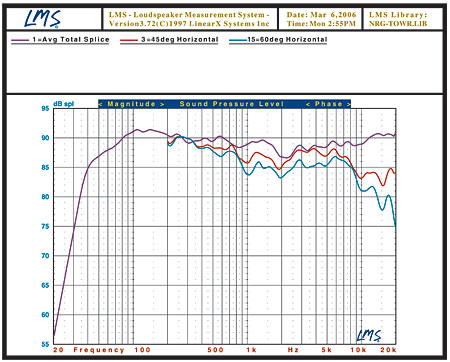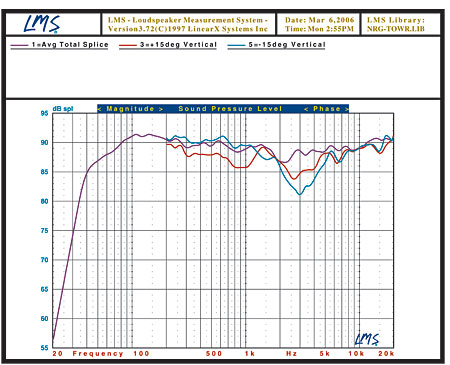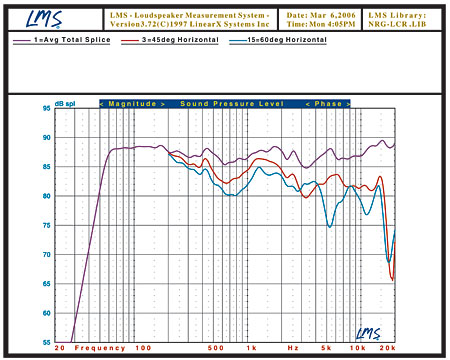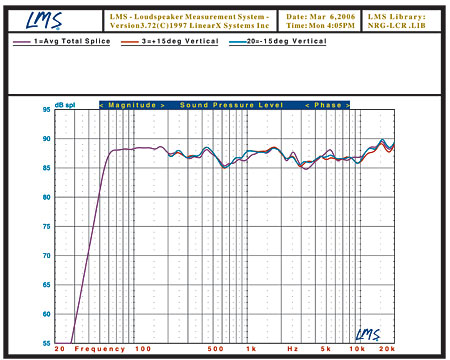Energy Reference Connoisseur RC-70 Surround Speaker System Measurements
The ported enclosure of the RC-70 was tuned to approximately 45Hz, with a minimum impedance magnitude of 4.3 ohms at 141Hz. I would rate its nominal impedance at approximately 6 ohms. The phase of the impedance is benign up to 3kHz, but becomes increasingly capacitive as frequency increases. This should cause no difficulty for a good amplifier (there is little power required at high frequencies). I would judge this speaker to be relatively easy to drive. The sensitivity measured approximately 89dB/2.83V/m—a comfortably high value but slightly less than the specification.
The horizontal front response of the RC-70 is shown in Fig.1 (violet). This is the pseudo-anechoic response averaged over a 30-degree forward horizontal angle (+/-15 degrees), at tweeter height, combined with the nearfield responses of the woofers and port. The effective measured lower limit of the RC-70 was 35Hz (-10dB relative to the speaker's output was 100Hz).

Fig.1: Reference Connoisseur RC-70 pseudo-anechoic response off the horizontal axis at 45 degrees (red) and 60 degrees (blue).
The averaged front horizontal response of the RC-70 is very smooth. There is a slight rise in the 100-200Hz region, which may relate to the slight warmth I occasionally heard. It was as benign audibly as the measured response suggests. The most obvious aberration is a slight dip in the response in the low treble, extending from about 1.5kHz to 5kHz. It averages roughly -2dB in depth, with a maximum of -3.5dB at about 2kHz. This could well be the source of the slightly forgiving nature I observed in the speaker on bright program material, but the dip isn't deep enough to make the speaker sound unnaturally recessed. The tweeter's response rises back to the level of the bass at higher frequencies and remains strong up to our measurement limit of 20kHz. The direct on-axis response (not shown) follows the 30-degree averaged response shown quite closely, even at the highest frequencies. The measurements were made without the grille. The latter adds significant roughness to the response above about 2.5kHz and should be removed for serious listening.
The RC-70's response at wide off-axis (horizontal) angles was competitive with most speakers we have measured. The vertical response shown in Fig.2 indicates that the RC-70 should be auditioned as close as possible to the tweeter axis for the smoothest response. (The tweeter's elevation of about 37.5" from the floor is a relatively common ear height for the average listener in a typical upholstered seat.)

Fig.2: Reference Connoisseur RC-70 pseudo-anechoic response at 15 degrees above (red) and 15 degrees below (blue) the tweeter.
The RC-LCR center channel's cabinet was tuned to about 60Hz. Its minimum impedance was 4.1 ohms, also at 60Hz. I would rate the nominal impedance at 6 ohms. The sensitivity measured about 87db/2.83V/m (like the RC-70, a comfortably high figure but slightly lower than specified). The impedance curve is very uniform and the phase angle benign at all frequencies. The RC-LCR appears to be a very easy load to drive.
The averaged front horizontal response of the RC-LCR is shown in Fig.3 (violet). While a little more erratic than the response of the RC-70 (and with a rising response above 10kHz—about +3.5dB at 15kHz relative to the response at 9kHz), the overall balance is satisfactory. And while the off-axis response is also a little uneven, it is flatter than we have measured from any center channel design that only uses three drivers in a woofer-tweeter-woofer configuration. The responses at 15-degrees and 30-degrees off-axis, not shown here, show curves that are relatively close to the averaged on-axis response. Bottom line: the RC-LCR's unusual configuration is definitely more effective than any horizontal woofer-tweeter-woofer model we have reviewed (though less effective than the best center channel designs that use a vertically configured midrange and tweeter flanked by a woofer on each side).

Fig.3: Reference Connoisseur RC-LCR pseudo-anechoic response off the horizontal axis at 45 degrees (red) and 60 degrees (blue).
The vertical off-axis response of the RC-LCR follows the on-axis average almost perfectly (Fig.4), making the vertical seating height relatively non-critical.

Fig.4: Reference Connoisseur RC-LCR pseudo-anechoic response at 15 degrees above (red) and 15 degrees below (blue) tweeter.
Since the RC-LCR may be positioned vertically, we also measured its off-axis response in that orientation. It proved to be relatively free of serious dips and peaks even at the maximum measured off-axis angle of 60-degrees. Although its response at such angles does drop to a lower plateau above 1kHz, it holds up well to 15kHz where it peaks slightly before falling off rapidly above that frequency.
The grille was just as detrimental to the response of the RC-LCR as in the RC-70 and I would restrict its use to casual listening.
While not remarkable in any particular respect (apart from the welcome lack of a dip in the impedance to below 4 ohms we see in many speakers), this is a solid set of measurements for a very well engineered speaker system.—TJN
All figures: Violet curve: pseudo-anechoic response on tweeter axis, averaged across a 30-degree horizontal window, combined with nearfield woofer and port responses. All measurements taken at 1 meter.
























































